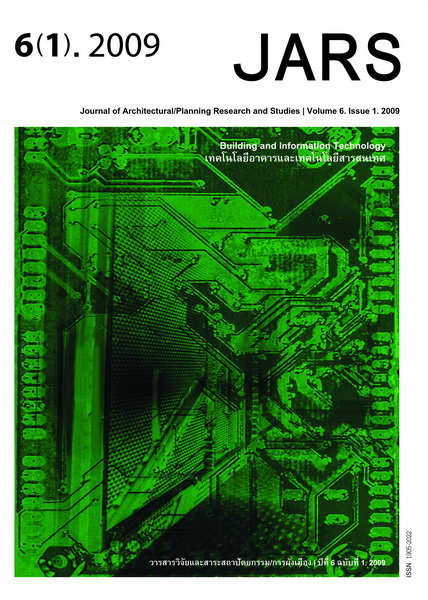The Efficiency of Structural Sealant Glazing (SSG) on Timber Frame: The Innovative Facade System for Sustainable Environment
Main Article Content
Abstract
This paper presents the study on the efficiency of facade system ‘the structural sealant glazing (SSG)
on timber frame’ concerning the architectural and environmental constraints. The idea of utilizing SSG on
timber frame as innovative facade system has enrolled towards an energetic action of sustainable development
for the new building construction market as well as the existing architectural transformation and renovation. In
fact, the principle of ‘SSG on timber frame’ is aimed to be the substitution of the metallic frame. The timber frame
is attached to a glass panel by structural silicone adhesive in which the timber frame must be protected from
inclement weather; from air infiltration and water penetration by the effective protection joints. The results
demonstrated the efficiencies of ‘SSG on timber frame’ with several architectural advantages especially for
environmental aspects. In comparison with the common materials used in construction such as concrete, glass,
metal, and wood (or timber), wood is the only one material derived from a renewable resource, it requires less
energy in production and reduce Greenhouse Effect Gases (GEG) in the atmosphere by stocking CO2 gas, in
contrast with metal and concrete that emit CO2 gas. In term of architectural aspect, the efficiency of SSG on
timber frame is absolutely not only the architectural esthetic quality but also the advantage in mechanical
performances better than metal especially the light mass aspect, moreover regarding in thermal and acoustic
comfort leading to improving the energy preservation of building envelope.
Downloads
Article Details

This work is licensed under a Creative Commons Attribution-NonCommercial-NoDerivatives 4.0 International License.
All material is licensed under the terms of the Creative Commons Attribution 4.0 International (CC-BY-NC-ND 4.0) License, unless otherwise stated. As such, authors are free to share, copy, and redistribute the material in any medium or format. The authors must give appropriate credit, provide a link to the license, and indicate if changes were made. The authors may do so in any reasonable manner, but not in any way that suggests the licensor endorses you or your use. The authors may not use the material for commercial purposes. If the authors remix, transform, or build upon the material, they may not distribute the modified material, unless permission is obtained from JARS. Final, accepted versions of the paper may be posted on third party repositories, provided appropriate acknowledgement to the original source is clearly noted.
References
ADEME. (2000). [Environmental quality of buildings]. Paris: Author.
CNDB. (2003). [CO2 absortion and stock in photosynthesis]. Retrieved August 3, 2004, from http://www.cndb.fr/,
CTBA. (1997). [Fitting the glass at factory and workshop: Compendium of procedures and qualifications of certified windows]. Paris: Author.
ENSTIB. (2004). [Carbon emission during the life cycle of basic beams made by different material]. Retrieved August 16, 2004, from http://www.enstib.uhp-nancy.fr/,
EOTA. (1998). [Guide for European technical approval for the structural sealant glazing system (SSG)]. Bruxelles, Belgium: Author.
ITBTP. (1989). [Structural sealant glazing (SSG): Guide design and implementation] Annales de l’ITBTP n o473. Paris: Author.
Legrande, G. (2002). [Validation of an innovative technique structural sealant glazing (SSG) on wood]. Bordeaux cedex, France: CTBA.
RT2000. (2003). [Thermal performance of materials; wood, metal and aluminum]. Retrieved September 21, 2004, from http://www.rt2000.net/,
STEP. (1994). [Energy cost of material compared; wood, metal and aluminum]. Retrieved September 21, 2004, from http://www.step.fr/fr/index.htm,


